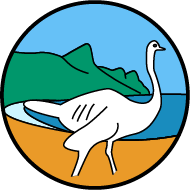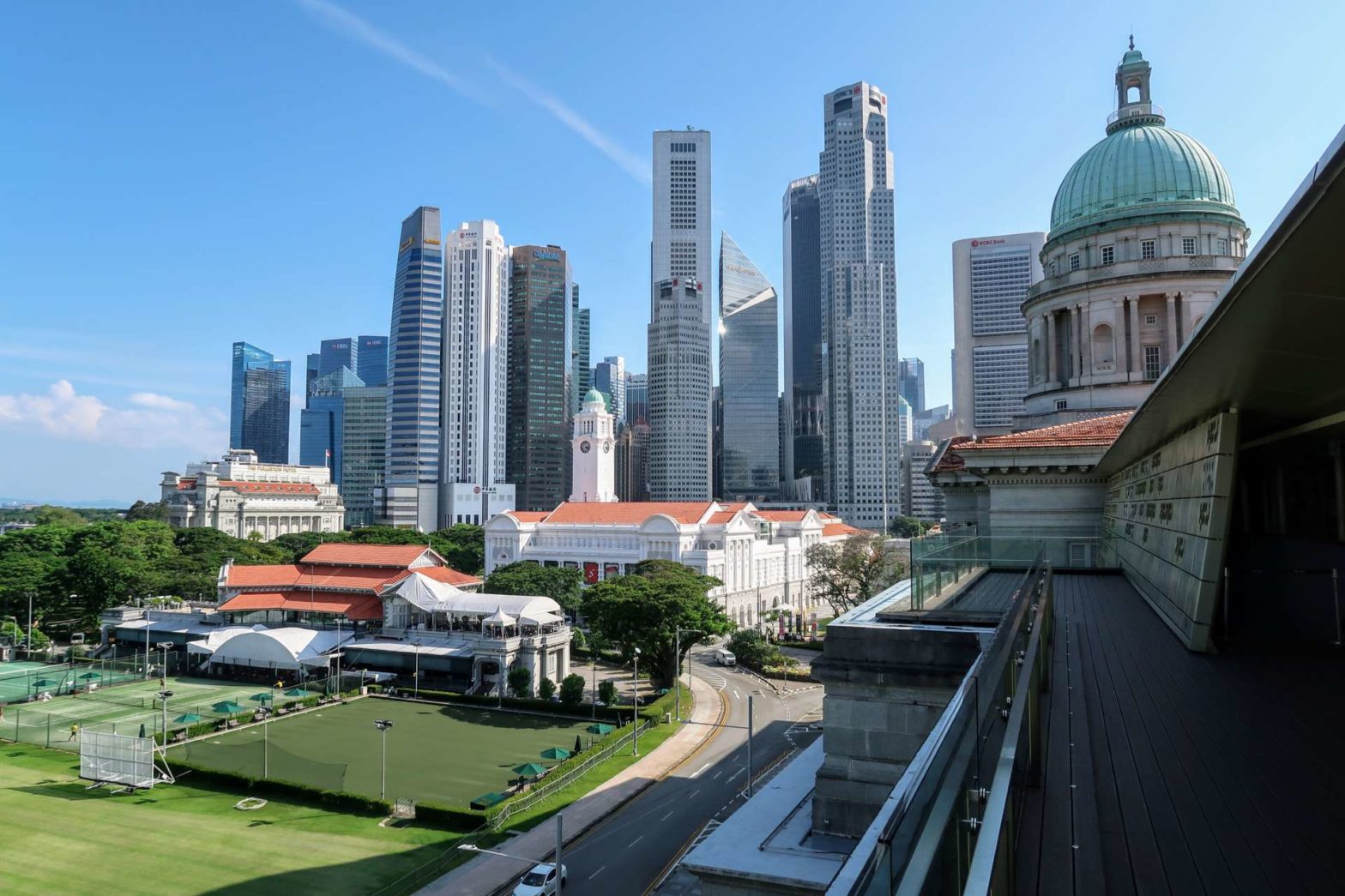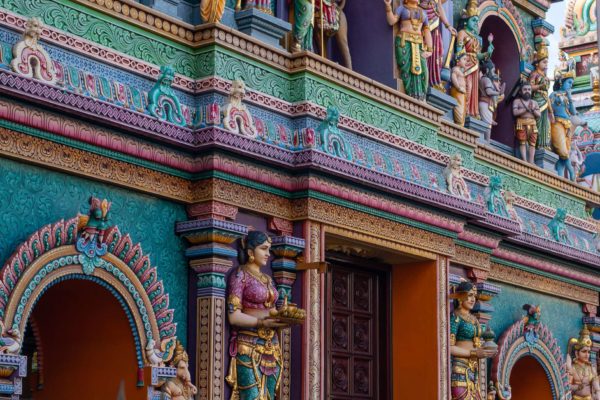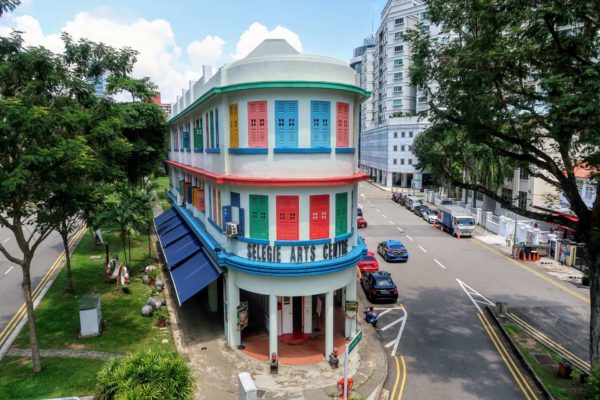By Vicky · Published Feb. 24th, 2022 · Updated Mar. 12th, 2023
When you buy through links highlighted with an asterisk (*) on this site, we may earn a small affiliate commission at no cost to you.
Take a stroll through history on this self-guided Colonial District Walking Tour. Explore the main sights and take in great viewpoints, a must for anyone visiting Singapore.
Page Contents:
How to get to Colonial District
This hike starts from City Hall MRT Station on the red North-South and green East-West lines. The hike ends at the National Gallery Singapore from where you can either return to City Hall MRT Station a few hundred metres away, walk on to explore the Marina District, return towards the Singapore River or head elsewhere.
Colonial District Walking Tour Map
Get the route by downloading the .gpx or .kml file below. For navigation with Maps.me on your mobile phone, simply download the .kml file and open to add it to the Maps.me bookmarks.
Tips for Colonial District Walking Trail
- The museums on this walking tour are normally open from 10am-7pm daily.
- Pop into the museums in the middle of the day, when their air-conditioning is a welcome break from the hot outdoors.
- Explore the other historic districts of Singapore on our Little India Walking Trail, Kampong Glam Walking Trail or Bras Basah Walking Trail.
Attractions in the Colonial District
On this walking trail you’ll see the main sights, attractions and museums of the Colonial District (also known as the Civic District):
- St Andrew’s Cathedral
- Raffles Hotel
- Chijmes
- Singapore Art Museum
- National Museum of Singapore
- Armenian Street
- Peranakan Museum
- Armenian Church
- Central Fire Station
- Parliament Of Singapore
- Asian Civilisations Museum
- Fullerton Hotel
- Victoria Concert Hall
- The Padang
- National Gallery Singapore
You could easily spend a few days walking around the colonial district, especially if you visit all five major museums. If you don’t go into any buildings this walking tour will take roughly two hours at a leisurely pace. If you prefer a guided tour, check out the various tours of the Colonial/Civic District*.
Colonial District Walking Trail Route
This walking trail starts from City Hall MRT station, Exit B. Just across the road you’ll see the fancy white Capitol Kempinski Hotel (Website, Booking Reviews*). Head to the nearby corner to see the curved front, with its intricate facade from 1904.
Directions: Turn around and the first stop is before you.
1. St Andrew’s Cathedral
Key Information: Open Tue-Fri 9am-5pm, Sat 11.30am-6.30pm, Sun 7.30am-5.30pm. Closed Mon & PH. Please note that the Cathedral Nave is currently closed for restoration, but a Virtual Tour is available here.
St Andrew’s Cathedral (Website, Tripadvisor Reviews*) is a little old Anglican church in the middle of a grassy area. It looks slightly out of place surrounded by all the modern buildings. You can enter the grounds and the inside of the church during open hours. The nave is bright and colourful with lovely stained glass windows.
The church’s architecture is Gothic Revival style and convict Indian labourers actually constructed it in 1861. Though it looks fairly small to be the main cathedral, the church is just the tip of the iceberg. Underneath are two large basements from 2003, including a large worship hall.
Directions: Once you’ve looked around the church, head towards the park with the tall white pillar in the middle.
The tall white object is the War Memorial. It commemorates the roughly 50,000 civilians killed during the Japanese Occupation of Singapore in the Second World War. It sits atop a burial chamber that contains exhumed bodies from mass graves dotted around Singapore.
Directions: Continue to the corner of the park on the left of the artsy blue skyscrapers with a wavey design. On the opposite corner is Raffles Hotel, which takes up the entire block.
2. Raffles Hotel
This legendary hotel (Website, Booking Reviews*) started off as a 10-room hotel occupying a bungalow by the beach. Today it’s still on Beach Road, but land reclamation means the sea is now over 2 km away. The main building opened at the turn of the century, in 1899, with the first electric lights in the whole of Singapore. After low points in the 1930s great depression and the 1970s, two subsequent renovations returned Raffles Hotel to its original splendour.
You can go inside the Raffles courtyards to view the tranquil gardens, admire the architecture and check out the fancy stores and restaurants. The main front entrance is on Beach Road, just to the right of the corner where you arrived.
The many famous guests of Raffles include Charlie Chaplin, Rudyard Kipling, Pablo Neruda, Joseph Conrad, John Wayne, Liv Tyler and Michael Jackson. It’s even rumoured that Rudyard Kipling wrote The Jungle Book while staying here.
Another claim to fame for Raffles Hotel is as the birthplace of the famous Singapore Sling cocktail. Ngiam Tong Boon, a bartender, created it here in 1915. Head to the Raffles Long Bar (Website, Tripadvisor Reviews*) for a pricey taste of the original. There are several other cafes and restaurants inside.
Directions: Leave Raffles onto Bridge Road near the Long Bar and turn left to the corner with Bras Basah Road. Chijmes, the next stop, is on the opposite corner of the roads. To reach the entrance walk up Bras Basah Road and turn left, with the entrance shortly on your left.
3. CHIJMES
CHIJMES (Website, Tripadvisor Reviews*) is a shopping and dining complex centred on a gleaming white gothic chapel. The name is an anacronym for Convent of the Holy Infant Jesus Middle Education School. It’s a historic complex that started out as a Catholic convent in 1852.
Its focus today is a Gothic-style church, now used for concerts and weddings – the wedding scene from Crazy Rich Asians was filmed here. Around the church are many restaurants and bars, a pleasantly quiet square in the middle of the bustling city. The famous former Hotel Van Wijk (which features in the great murder mystery book Singapore Sapphire*, set in 1910) was located just next door on Stamford Road.
Directions: Return to the entrance and just opposite is the Cathedral of the Good Shepherd.
The Cathedral of the Good Shepherd (Website, Tripadvisor Reviews*) is the main and oldest (from 1847) Roman Catholic Church in Singapore. Mass is still popular today.
Directions: One block further up on Bras Basah Road is the Singapore Art Museum, opposite the strange water features.
4. Singapore Art Museum
Key Information: The Singapore Art Museum is closed until 2026.
The Singapore Art Museum (Website, Tripadvisor Reviews*) is closed until 2026 but promises big things on its reopening. This museum focuses on contemporary art from Southeast Asia. A gorgeous colonial building that used to be a Catholic boys’ school houses the collections.
Museums in Singapore Colonial District
The five main museums of Singapore are all in the Colonial District and you could spend a couple of hours to half a day in each one. I found the top three museums on the list below most interesting because they help you understand the history and culture of Singapore and the surrounding regions. The two art museums are both in wonderful buildings but the collections themselves are not outstanding.
- Peranakan Museum – focussing on a unique culture, helps to understand Singapore and Southeast Asia
- National Museum of Singapore – history of Singapore and more (get tickets here*)
- Asian Civilizations Museum – similar to the British Museum or Metropolitan Museum, but focussing on Asian Civilizations (get tickets here*)
- National Gallery Singapore – in a great building, the artworks themselves are so-so (get tickets here*)
- Singapore Art Museum – also in a lovely building but with mediocre art on display
Directions: Cross over the strange water features and past the glassy SMU library. You’ll see the next grand museum on the other side of the road.
5. National Museum of Singapore
Key Information: Open daily from 10am – 7pm. It’s free for locals and $15 for others, with reduced rates of $10 for students and seniors. Special exhibitions cost extra. The museum is large so allow several hours. Buy reduced-price tickets here*.
Visiting the National Museum of Singapore (Website) is a great way to learn about the history of this country. It opened in 1849 as the Raffles Library and Museum. It now contains exhibits about the Malay Archipelago, the East Indies and the Founding of Singapore, Reminisces of Singapore in the early post-war years, the Japanese Occupation and many more. There’s also a pleasant museum cafe on the ground floor.
The Singapore History Gallery is particularly worthwhile as you trace back the development of the island as a trading station. The Story of the Forest Exhibition, while a bit tacky, is quite fun as you walk round and down beneath the Rotunda to the basement following animated designs of animals in a Malaysian forest.
Directions: If you want to extend this walk and visit historic Fort Canning, now is a good time as it’s just behind the museum. Otherwise, head to the left of the museum building and through/beneath part of Singapore Management University to the road corner on the other side. Cross the road and you’ll be on the pedestrianised Armenian Street.
6. Armenian Street
Armenia is a small country on the edge of the Black Sea nestled between Russia and Turkey. But why is there a street named after it in Singapore? Armenians migrated all over the British Empire in Asia, especially to India, and when Stamford Raffles proclaimed Singapore as a trading port in 1819, they also migrated here. The Armenian Community had a large influence in early colonial times and many worked in well-respected professions.
Probably the most famous Armenians in Singapore were the Sarkies Brothers who started Raffles Hotel. Another Armenian who left her mark was Agnes Joaquim who created the hybridised orchid known today as Vanda ‘Miss Joaquim’, Singapore’s National Flower (which you can see in the Botanic Gardens). Catchick Moses co-founded the Straits Times in 1845, still going strong today.
The prominent red and white edifice of Vanguard Building marks the start of Armenian Street. A bookshop operated in this building from 1908 to 2003 and it’s now part of Singapore Management University (SMU)
Directions: Halfway along Armenian Street on the right-hand side is the Peranakan Museum.
7. Peranakan Museum
Key Information: Open daily 10am-7pm, Fri 10am-9pm. Free for locals and $12 for others, with reduced rates of $8 for students and seniors.
A lovely former school building from 1912 houses the Peranakan Museum (Website, Tripadvisor Reviews*). Ornate verandas wrap each floor, shaded by delicate black-and-white blinds. The Museum contains many Peranakan objects and explains the culture of Peranakan communities in Southeast Asia.
Directions: After the Peranakan Museum, continue along the street.
At the end of the street you’ll see the colourful new Children’s Museum (Website, Tripadvisor Reviews*) and next to that an old Masonic Lodge, now containing a restaurant called the Masons Table (Website, Tripadvisor Reviews*).
The Peranakan Community and Baba-Nyonyas
The Peranakan Comunity, also known as Straits Chinese, are those who came from China to settle in this region from the 14th to 17th centuries. They typically set up successful trading businesses and became very wealthy. Their unique culture is a blend of ancient Chinese and local Malayan cultures and interracial marriages were common. Peranakans are also known as Baba-Nyonyas, the honorific title for a man and woman.
Directions: On the left-hand side of the road you’ll see the Armenian Church, with its entrance around the corner on busy Hill Street.
8. Armenian Church
Key Information: Open daily 10am-6pm by appointment only due to Covid-19.
The full name of this church is the Armenian Apostolic Church of St. Gregory the Illuminator (Website, Tripadvisor Reviews*) and it’s been here since 1835. It’s the oldest surviving church in Singapore, built at the time for the rapidly growing population of Armenians living here.
The old bungalow to the left of the church used to be the Parsonage and is now the administrative office of the church. The peaceful grounds surrounding the church is the Memorial Garden, containing tombstones of prominent Armenians such as Agnes Joaquim and Catchick Moses.
History of Colonial District
Raffles arrived in Singapore in 1819 and established it as a trading centre. He made the original city plan of Singapore, in which he designated the area just north of the river for Europeans, as well as churches, hotels and civic buildings. This area forms the core of the Colonial District today. The main features of the Colonial District are the many grand neo-classical colonial buildings that dot the area. Most of these buildings were constructed from the mid-1800s to the early-mid 1900s and have since undergone extensive renovations.
Directions: Head the other direction along Hill Street to a very distinctive red and white striped building.
9. Central Fire Station
This unique fire station is still in use today. One of the few brick buildings in Singapore, from 1909. A professional firefighter from the UK came over in 1904 to modernise Singapore’s fire brigade, and he was instrumental in the building of the current fire station. In World War II the army painted the fire station completely green to avoid the Japanese bombs. The tower, a lookout tower for checking on smoke, was the tallest tower in Singapore until the 1930s.
Head to the Civil Defence Heritage Gallery inside this building, or cross over the road for better views of the stripy outside.
Civil Defence Heritage Gallery
This small gallery (Website, Tripadvisor Reviews*) is inside the Central Fire Station. It showcases the firefighting history of Singapore, including photos of significant fires and an old fire engine. You can also climb up the lookout tower.
Directions: Continue along Hill Street until the river.
On the corner you’ll see the Old Hill Street Police Station, a wonderful building with colourful shutters. Built for the police in 1934, it was then regarded as a skyscraper. It seems laughable today, but at the time it really was one of the tallest buildings in Singapore. Today there are a few small art galleries on the ground floor that you can pop into.
Directions: Head left along the river and cross underneath Elgin Bridge.
The Earl of Elgin, a colonial administrator, gave his name to Elgin Bridge, an iron bridge from 1929. It was the first permanent bridge across the Singapore River. Just further on from the bridge there are nice views across the river to Boat Quay on the other side.
Directions: The Parliament is now on your left.
10. Parliament of Singapore
If you want to go inside the Parliament (Website, Tripadvisor Reviews*) you have to leave the river and walk around the building to the other side to reach the entrance. There are historical artefacts, free guided tours and a gift shop. You can also view the Parliament Proceedings which start around 1:30 pm most weekdays. They are sometimes fussy about taking photos and you also have to be dressed appropriately (no beach or sportswear) to enter.
Directions: Head back and continue along by the river.
On your left you can see the alien spaceship of the Supreme Court, with the round glass symbolising transparency of the justice system. A short while later you’ll reach a Statue of Sir Stamford Raffles at the location where he officially landed many years ago in 1819. There are many colonial buildings here and if you stroll a little way up the lane here you’ll see the Old Parliament House, also known as the Arts House. Parliament sat here until 1999 and it’s possibly the oldest remaining building in Singapore, built in 1827.
Directions: Return to the riverbank and continue around the corner to the entrance of the next museum.
11. Asian Civilisations Museum
Key Information: Open from 10 am to 7 pm every day, or until 9 pm on Fridays. It’s free for locals and $25 for others, with reduced rates of $20 for students and seniors. Children under 6 are free. Buy reduced price tickets here*.
The Asian Civilisations Museum (Website, Tripadvisor Reviews*) has a large collection of treasures from around Asia. A highlight is the Tang Shipwreck, an Arab ship from 1100 years ago that sank off Sumatra, rediscovered only in 1998. Its cargo has been beautifully preserved and displayed, with thousands of unique bowls that look like they could have been made yesterday.
Another wonderful exhibit displays artefacts from the great Asian religions and chronicles their spread. There are several other galleries, as well as an all-day cafe (Privé ACM) and a fancier restaurant called Empress.
Directions: Cross the river on Cavenagh bridge to the Fullerton Hotel before returning across Anderson Bridge.
Opened in 1869, Cavenagh Bridge is named after Major General Cavenagh, Governor of the Straits Settlements from 1859 to 1867. Before the bridge was built, your two options for crossing the river were to pay for a boat or head upstream to Elgin Bridge. Don’t miss the old sign stating that cattle and horses are banned from crossing.
Anderson Bridge was completed in 1910 and named after a different Governor. Busy and ever-increasing trade around the river meant that the smaller Cavenagh Bridge couldn’t cope. This newer bridge eased the queues of heavy merchant traffic. Today it’s an exciting part of the Singapore Grand Prix circuit, as the cars whizz across between the old iron structure.
12. Fullerton Hotel
The Fullerton Hotel (Website, Booking Reviews*) is one of the most famous and distinctive sights in the Colonial District. It looks tiny compared to the huge skyscrapers of the Financial District just behind it. The first Governor of the Straits Settlements gave his name to this monument. The current building dates from 1924, though it was built over a fort from 100 years earlier which guarded the river mouth with a large gun.
This luxury hotel contains several restaurants and bars, with a classic highlight being afternoon tea in The Courtyard. The Fullerton Waterboat House next to the hotel, a historic water supply house, now contains a European-style bistro called Picotin (Website, Tripadvisor Reviews*).
If you’re not going on a walk around the Marina, pop right and over the highway to the famous Merlion Statue before returning.
Directions: Cross back over to the other side of the river on Anderson Bridge.
13. Victoria Concert Hall
The distinctive Victoria Concert Hall (Website, Tripadvisor Reviews*) is just across the lawn from the river. The neoclassical design comes from the early 1900s and it’s always been a place to enjoy entertainment, first as a Town Hall and later as a Concert Hall. Just in front of the building is the original statue of Sir Stamford Raffles – the one by the river is just a replica.
Directions: Head back to walk along the river a bit further.
You are now in Esplanade Park, full of majestic broad-crowned rain trees. Continue along by the water and just around the corner to a great photo spot of the financial district.
Directions: Head away from the river and through Esplanade Park to reach the big green open space of the Padang.
14. The Padang
Padang is Malay for ‘field’, and the Padang in the centre of Singapore is just one big grassy field. Raffles himself set aside this land for public use, though today it’s mostly private and you can only walk along a narrow path across the centre. The open grassy spaces on either side are used exclusively by the fancy Singapore Cricket Club on your left and the more modern Singapore Recreation Club on your right.
Many historic events took place here, including the handing over of Singapore back from the Japanese. Today the National Parade takes place here every year in August. There are great views from the Padang, with the National Gallery Singapore on the far side.
15. National Gallery Singapore
Key Information: Open from 10 am to 7 pm every day. It’s free for locals and $20 for others, with reduced rates of $15 for students and seniors. Children under 6 are free. Buy reduced price tickets here*.
The National Gallery Singapore (Website, Tripadvisor Reviews*) is a large art museum occupying two colonial buildings – the former Supreme Court and City Hall. These buildings were joined and redesigned to form the museum, and the blend of modern and old architecture is very well done. The art exhibits themselves are very diverse, from old to modern and from Asia to Europe.
If you don’t want to pay to see the art, at least head in to see the atrium and architecture. You can head to the roof for free and visit Smoke & Mirrors, a bar with views (Website, Tripadvisor Reviews*). From the balcony, you can see over the Pandang, to the financial district and Marina Bay Sands.
Directions: This is the end of the Colonial District Walking Tour. From here you can either return to City Hall MRT Station a few hundred metres away, walk on to explore the Marina District, return towards the Singapore River or head elsewhere.
Colonial District Walking Trail at Night
Although the museums are closed, it’s rather pleasant walking around the area after dark (7pm). Most of the buildings are lit up nicely and it is cooler than during the day.
If you want to experience another Singapore heritage trail, why not check out our Kampong Glam Walking Trail, Little India Walking Trail or Bras Basah Walking Trail. For more walks and hikes, check out our Singapore Guide.
FAQS – Colonial District Walking Trail
The Singapore Colonial District is known for its many large, neoclassical colonial buildings and famous museums.
The street was named after the nearby Armenian Church, and the church was named after the community that built it. In the 1800s the Armenian Community had a lot of influence in Singapore and jobs in many respected professions.
The Cathedral of the Good Shepherd was built in 1847.
In colonial times the Fullerton Hotel was the central post office and venue of the Singapore Club, a fancy club for rich colonialists.
To get to Colonial District take the MRT to City Hall station on the green East-West and red North-South lines. Alternatively, take the MRT to Raffles Place (on the green East-West line) and then pop across the river. There are also many bus stops in the Colonial District.
Take the MRT to City Hall station. Walk up Stamford Road by the Capitol Kempinski Hotel and turn right on Victoria Street. The entrance to Chijmes is on the right, 100 metres along Victoria Street.
Chijmes is famous for its beautiful Gothic Revival Chapel (as seen in Crazy Rich Asians) and the surrounding bars and restaurants.
Chijmes stands for Convent of the Holy Infant Jesus Middle Education School. It’s a historic complex that started out as a Catholic convent in 1852.








